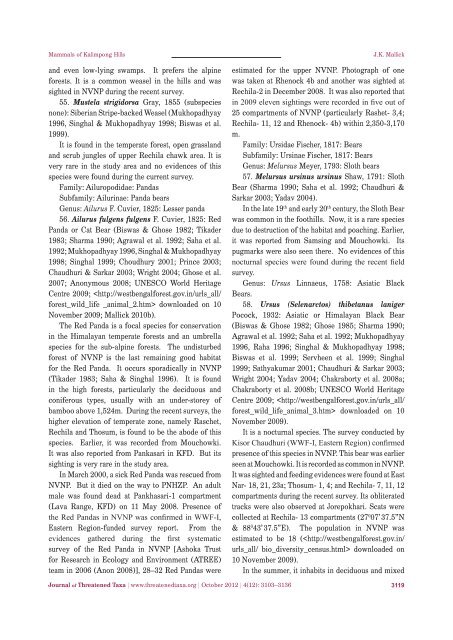October 2012 - Journal of Threatened Taxa
October 2012 - Journal of Threatened Taxa
October 2012 - Journal of Threatened Taxa
Create successful ePaper yourself
Turn your PDF publications into a flip-book with our unique Google optimized e-Paper software.
Mammals <strong>of</strong> Kalimpong Hillsand even low-lying swamps. It prefers the alpineforests. It is a common weasel in the hills and wassighted in NVNP during the recent survey.55. Mustela strigidorsa Gray, 1855 (subspeciesnone): Siberian Stripe-backed Weasel (Mukhopadhyay1996, Singhal & Mukhopadhyay 1998; Biswas et al.1999).It is found in the temperate forest, open grasslandand scrub jungles <strong>of</strong> upper Rechila chawk area. It isvery rare in the study area and no evidences <strong>of</strong> thisspecies were found during the current survey.Family: Ailuropodidae: PandasSubfamily: Ailurinae: Panda bearsGenus: Ailurus F. Cuvier, 1825: Lesser panda56. Ailurus fulgens fulgens F. Cuvier, 1825: RedPanda or Cat Bear (Biswas & Ghose 1982; Tikader1983; Sharma 1990; Agrawal et al. 1992; Saha et al.1992; Mukhopadhyay 1996, Singhal & Mukhopadhyay1998; Singhal 1999; Choudhury 2001; Prince 2003;Chaudhuri & Sarkar 2003; Wright 2004; Ghose et al.2007; Anonymous 2008; UNESCO World HeritageCentre 2009; downloaded on 10November 2009; Mallick 2010b).The Red Panda is a focal species for conservationin the Himalayan temperate forests and an umbrellaspecies for the sub-alpine forests. The undisturbedforest <strong>of</strong> NVNP is the last remaining good habitatfor the Red Panda. It occurs sporadically in NVNP(Tikader 1983; Saha & Singhal 1996). It is foundin the high forests, particularly the deciduous andconiferous types, usually with an under-storey <strong>of</strong>bamboo above 1,524m. During the recent surveys, thehigher elevation <strong>of</strong> temperate zone, namely Raschet,Rechila and Thosum, is found to be the abode <strong>of</strong> thisspecies. Earlier, it was recorded from Mouchowki.It was also reported from Pankasari in KFD. But itssighting is very rare in the study area.In March 2000, a sick Red Panda was rescued fromNVNP. But it died on the way to PNHZP. An adultmale was found dead at Pankhasari-1 compartment(Lava Range, KFD) on 11 May 2008. Presence <strong>of</strong>the Red Pandas in NVNP was confirmed in WWF-I,Eastern Region-funded survey report. From theevidences gathered during the first systematicsurvey <strong>of</strong> the Red Panda in NVNP [Ashoka Trustfor Research in Ecology and Environment (ATREE)team in 2006 (Anon 2008)], 28–32 Red Pandas wereJ.K. Mallickestimated for the upper NVNP. Photograph <strong>of</strong> onewas taken at Rhenock 4b and another was sighted atRechila-2 in December 2008. It was also reported thatin 2009 eleven sightings were recorded in five out <strong>of</strong>25 compartments <strong>of</strong> NVNP (particularly Rashet- 3,4;Rechila- 11, 12 and Rhenock- 4b) within 2,350-3,170m.Family: Ursidae Fischer, 1817: BearsSubfamily: Ursinae Fischer, 1817: BearsGenus: Melursus Meyer, 1793: Sloth bears57. Melursus ursinus ursinus Shaw, 1791: SlothBear (Sharma 1990; Saha et al. 1992; Chaudhuri &Sarkar 2003; Yadav 2004).In the late 19 th and early 20 th century, the Sloth Bearwas common in the foothills. Now, it is a rare speciesdue to destruction <strong>of</strong> the habitat and poaching. Earlier,it was reported from Samsing and Mouchowki. Itspugmarks were also seen there. No evidences <strong>of</strong> thisnocturnal species were found during the recent fieldsurvey.Genus: Ursus Linnaeus, 1758: Asiatic BlackBears.58. Ursus (Selenarctos) thibetanus lanigerPocock, 1932: Asiatic or Himalayan Black Bear(Biswas & Ghose 1982; Ghose 1985; Sharma 1990;Agrawal et al. 1992; Saha et al. 1992; Mukhopadhyay1996, Raha 1996; Singhal & Mukhopadhyay 1998;Biswas et al. 1999; Servheen et al. 1999; Singhal1999; Sathyakumar 2001; Chaudhuri & Sarkar 2003;Wright 2004; Yadav 2004; Chakraborty et al. 2008a;Chakraborty et al. 2008b; UNESCO World HeritageCentre 2009; downloaded on 10November 2009).It is a nocturnal species. The survey conducted byKisor Chaudhuri (WWF-I, Eastern Region) confirmedpresence <strong>of</strong> this species in NVNP. This bear was earlierseen at Mouchowki. It is recorded as common in NVNP.It was sighted and feeding evidences were found at EastNar- 18, 21, 23a; Thosum- 1, 4; and Rechila- 7, 11, 12compartments during the recent survey. Its obliteratedtracks were also observed at Jorepokhari. Scats werecollected at Rechila- 13 compartments (27 0 07’37.5”N& 88 0 43’37.5”E). The population in NVNP wasestimated to be 18 ( downloaded on10 November 2009).In the summer, it inhabits in deciduous and mixed<strong>Journal</strong> <strong>of</strong> <strong>Threatened</strong> <strong>Taxa</strong> | www.threatenedtaxa.org | <strong>October</strong> <strong>2012</strong> | 4(12): 3103–31363119

















